PinotFile: 8.42 August 11, 2011
|
Not Too Late For Oregon ’08Serious pinotphiles are weary of vintage hype, but in the case of Oregon’s 2008 vintage, the exaltations are fully warranted. The Pinot Noirs from Oregon in 2008 have a dreamy combination of perfect ripeness and luscious flavors at modest alcohol levels (rarely crossing over 14.0%), added to impeccable balance that predicts age ability. Veteran Oregon winemakers liken the vintage to 1999, when the late harvest sunshine allowed vintners to leisurely pick their crop. The only negatives for this vintage are reduced yields that make top wines challenging to source, and the need for most of the best wines to be cellared at least five years. The wines do not offer the instant gratification that pinotphiles have become accustomed to with Oregon vintages of the past. I have been tasting Oregon Pinot Noir vintages since the early 1990s and I can say that the 2008 wines are stunning in comparison. If you don’t have at least five cases of 2008 Oregon Pinot Noir in your cellar bow your head. The 2008 Oregon Pinot Noirs are flirty, teasingly good now, but clearly in need of cellaring to integrate the tannins and reveal the nuances that reside deep within. I have reviewed many spectacular 2008 Oregon Pinot Noirs over the past year, but some wines have only recently reached the marketplace. Two factors were at play to explain this. First, a number of producers were trying to work through their inventory of 2007 Pinot Noirs which were not hyped by the wine press and were released during the nightmarish economy of 2009. After time in bottle, these wines have turned out to be classically styled Pinot Noir and perfect for short-term drinking. Second, many 2008 Pinot Noirs were closed initially and so tight that the consumer found the wines unappealing and were dismayed by the glowing reviews. A number of producers knew that these wines needed more time in bottle and held back releases as long as economically feasible. I checked a number of winery websites and found a plethora of great 2008s still available. Cristom Vineyards released their early drinking 2008 Mt. Jefferson Cuvée some time ago and this wine is one of the finest 2008s I have had from Oregon in its price range (widely available at under $30). This would bode well for the 2008 Eileen Vineyard, Louise Vineyard and Jessie Vineyard just now released by the winery ($50). Ponzi Vineyards still has the 2008 Reserve, Abetina, Aurora and Vineyard Select available. Other top 2008 Pinot Noirs now offered by wineries include: Argyle 2008 Nuthouse and Reserve; Et Fille 2008 Willamette Valley, Nicholas Vineyard, Kalita Vineyard and Deux Vert Vineyard; Laura Volkman 2008 Rachel, Jacob and St. James; Scott Paul 2008 La Paulee and Dom Denise; ROCO 2008 Private Stash; Beaux Frères 2008 The Beaux Frères Vineyard; White Rose 2008 Willamette Valley, Dundee Hills, Whole Cluster, Sovarge, and White Rose Vineyard; Lange Yamhill Vineyards and Cru Club Exclusives; Lenné 2008 Estate; and Cardwell Hill Cellars 2008 Estate and Reserve.
 All the wines reviewed below are either available from the winery directly or through the retail marketplace.
Anam Cara CellarsNicholas and Sheila Nicholas launched this boutique winery in 2001 primarily devoted to Pinot Noir from their Nicholas Estate Vineyard. 33 acres are owned and farmed in Newberg, Oregon, part of the Chehalem Mountains AVA. The L.I.V.E. certified vineyard has a complete palette of clones including Pommard, Wädenswil, and Dijon 114, 115, 667 and 777. Soils are primarily Loess with some outcrops of volcanic Jory. Planting started in 2001 with additions in 2008. Noted veteran winemaker Aron Hess (Daedalus, Jezebel and others) crafts about 1,000 cases annually of Anam Cara Pinot Noir, Gewürztraminer and Riesling (and eventually Chardonnay) at the Maple Wine Company shared winemaking facility in Dundee. Sheila is very active in Oregon wine events including the International Pinot Noir Celebration and ¡Salud! The Oregon Wine Auction. Anam Cara Pinot Noirs are consistently fine, styled in a robust fruity manner with substantial flavor intensity. The silky texture of the 2008 wines is impressive. Special bottlings require a few years in bottle for maximum enjoyment. The wines are sold on the website and through a mailing list. A new tasting room has opened close to the junction of 99W and Highway 240 in Newberg, across from the historic mill at 306 North Main Street. The tasting room is open daily 11:00-5:00. The website is www.anamcaracellars.com.
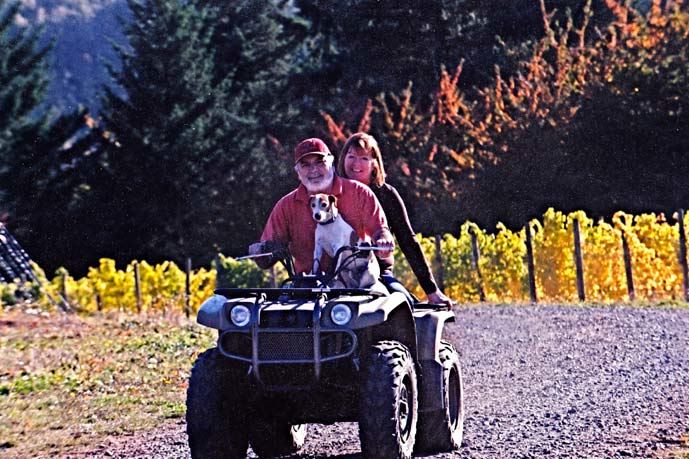
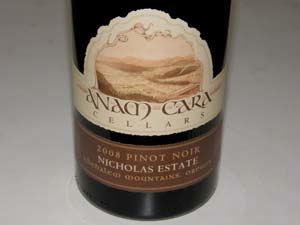 2008 Anam Cara Cellars Nicholas Estate Chehalem Mountains Pinot Noir 14.0% alc., 1,000 cases, $30. The flagship wine containing all five blocks of Pinot Noir. Aged in 18% new, 12% 1- year-old, and 70% neutral French oak barrels. 667 (37%), Pommard (22%), 115 (16%), 114 (13%) and 777 (12%). · Moderate reddispurple color. Glass-filling perfume of ripe berries, concord grapes and a subtle whiff of oak. Velvety on the palate with a discreetly concentrated mix of fresh black cherry and dark red berry flavors set off by complimentary oak. A seamless, solid drinker to be enjoyed now. Very Good.
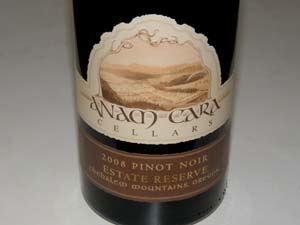 2008 Anam Cara Cellars Estate Reserve Chehalem Mountains Pinot Noir 14.0% alc., 180 cases, $40. From selected rows in each block with yields of less than 1.5 tons per acre. Aged in 17% new, 52% 1-year-old and 31% 2-year-old French oak barrels. 114 (48%), 777 (35%) and Pommard (17%). · Moderate reddish-purple hue in the glass. Very alluring aromas of dark plums, blackberries and black cherries with a complimentary hint of oak. Lovely core of earth-kissed and intensely flavored black cherry and black raspberry fruit. Ripe and sweet, round and polished. Silky smooth with perfect integration of oak and a glorious finish that lasts and lasts. Best Reserve ever from Anam Cara.
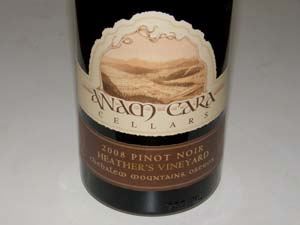 2008 Anam Cara Cellars Heather’s Vineyard Chehalem Mountains Pinot Noir 14.0% alc., 50 cases, $60. The most elegant wine in the lineup, using the lightest amount of oak. Sourced from a special ten rows cropped to 1.5 tons per acre. 114 (100%). The wine is named after the owners’ daughter. · Moderately light reddish-purple color in the glass. Initially reserved, but pleasing scents of red cherries and raspberries emerge over time with air. A demure wine on the palate offering a silky array of red Pinot fruits and very supple tannins. Assumes more interest and intensity over time in the glass. A charming ingenue.You can drink it now for its upfront sexiness, but it will be even more striking with additional maturity.
2008 Anam Cara Cellars Mark III Chehalem Mountains Pinot Noir 14.5% alc., 50 cases, $60. The antithesis of Heather’s: as big and rich as could be crafted using the boldest clones from the Reserve rows and barrels and the highest percentage of new oak (67%). 777 (67%) and Pommard (33%). Named for the owners’ son Mark, with the Roman numerals indicating the wine’s place in the series. · Moderately dark reddish-purple color in the glass. A metrosexual wine that is not as big and muscled as past vintages offering a lovely core of darker fruit hidden presently by the oak-derived aroma and flavor of coffee. Like the other Anam Cara Pinot Noirs in 2008, the texture is all silk and satin. This wine needs a few years in bottle to come together and integrate the oak, but I suspect it will always be at least modestly oaky. Good.
Daedalus CellarsWinemaker Aron and spouse Pam Walden founded Daedalus (DAY-de-lus) Cellars in 2000. The name comes from Greek mythology by way of James Joyce (see full explanation on the website). The focus is Pinot Noir, primarily from grapes grown in the Dundee Hills AVA. Production is at the 12th & Maple Wine Company, a custom crush facility in Dundee, which Aron designed and where he is the head winemaker, crafting wines for over twenty clients. Seven acres of vines were planted on an estate vineyard in the Dundee Hills in 2008 with the first release scheduled for the 2011 vintage. The wines are crafted in a rich and bold style with notable oak presence and the balance to age. The 2008 wines reviewed below are the finest I have tasted from this producer. Production is about 3,000 cases (another 5,000 cases of Jezebal wines, a value-priced line, are also available). A tasting room is located at 990 N. Highway 99 in Dundee (open Weds-Sun). The wines are sold on the website at www.daedaluscellars.com.
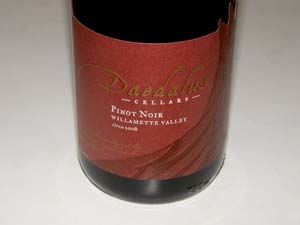 2008 Daedalus Cellars Willamette Valley Pinot Noir 13.0% alc., 1,180 cases, $25. Released May 2011. Sourced from five vineyards in three AVAs. Long cold-soak (21-36 days) with a cuvaison of 32 to 56 days. Native yeast fermentation. 15% whole cluster. Aged 21 months in 18% new French oak. · Moderately light reddish-purple color in the glass. Nicely perfumed with aromas of black cherries, violets, dark chocolate and a hint of oak. A lighter-weighted wine that still offers plenty of pleasure including flavors of red fruits, savory herbs and a hint of coffee. Supple tannins make for easy drinking now. Very Good.
2008 Daedalus Cellars Labyrinth Dundee Hills Pinot Noir 13.0% alc., 71 cases, $45. Released May 2011. A winemaker’s cuvée of the best wine in the cellar. 70% Maresh Vineyard, 20% Durant Vineyard and small amounts of Thistle and Murto vineyards. 53% Pommard, 38% Wädenswil and 9% mixed Dijon clones. Native fermentation. Cold soak 21-36 days with total cuvaison of 32-56 days. 15% whole cluster. Aged 21 months in 18% new French oak barrels. · Moderately light reddish-purple color in the glass. Enticing aromas of cherry tart, brioche, seasoned oak and dried rose petals. Delicious red raspberry flavor with complimentary spice and oak. Soft and juicy in the mouth with notable persistence on the fruit-filled finish. A lighter-weighted, but fulfilling wine. Very Good.
 2008 Daedalus Cellars Maresh Vineyard Dundee Hills Pinot Noir 12.4% alc., 24 cases, $60. Released May 2011. From the oldest vineyard on Worden Hill Road in the Dundee Hills. 60% Wädenswil and 40% Pommard clones. Since 2007, the southern half of the vineyard has been farmed by Daedalus organically. Yields 1.0-1.6 tons per acre. 32-day cold soak. Native fermentation. Unfined and unfiltered. · Lighter redder-toned color in the glass. Intense aromas of dark red cherries and berries with oak in the background. Impressive mid palate flavors of dark red cherries, raspberries and cranberries with complimentary oak spice and toast. Seamless, sophisticated and classy with a capital C. Very light on its feet and elegant in structure. Will be better over time as the oak integrates but hard to resist now.
Lenné EstateI reviewed the 2008 Pinot Noirs from Lenné Estate in the PinotFile a year ago (www.princeofpinot.com/article/947/). Owner Steve Lutz has a special vineyard just east of the town of Yamhill near Willakenzie Estate, Shea Vineyard, Soter Vineyards and Beaux Frères. The 20-acre vineyard was planted in 2001 and the winery was launched in 2002. The name, Lenné, (“Lenay”) is a French adaptation of the name of Steve’s father-in-law, Len, who raised his family including Steve’s spouse, Karen, on a chicken farm west of London, England. The Lenné Estate value bottling, Le Nez, features a side portrait of Len’s schnoz on the label and a silhouette of him appears on the Lenné Estate label. The wines under the Lenné Estate label represent the best barrels from the vineyard in each vintage. The wines are vinified in collaboration with noted Oregon vintner, David O’Reilly. Production in 2008 was 1,300 cases. The wines are largely sold through a mailing list and at the quaint hilltop tasting room (below) that is open on weekends or by appointment (503-956-2256). The 2008 growing season was ideal at Lenné Estate, with perfect fruit set and small, thick-skinned berries. Cool weather prevailed at harvest with no rain. The 2009 vintage Lenné Pinot Noirs are more approachable early, but will not be as long-lived (see the reviews of the 2009s elsewhere in this issue). I recently tasted the 2008 Lenné Estate Pinot Noir to compare with my tasting one year ago. The wine has taken on more intense flavors, offers a darker fruit profile, and displays full integration of oak now. Surprisingly, the wine is still available from the winery. Steve thinks the 2008 wines will show best from 2018 to 2022.
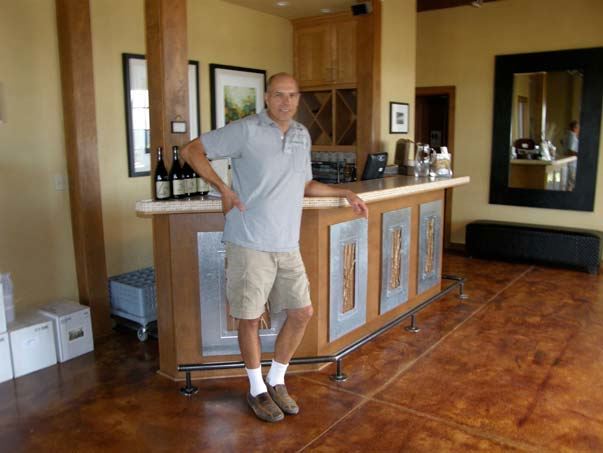
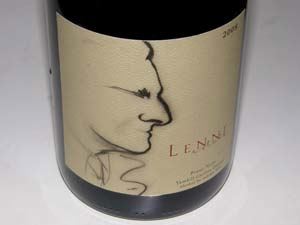 2008 Lenné Estate Yamhill-Carlton District Pinot Noir 14.0% alc., 496 cases, $45. A selection of the best barrels of 115 and Pommard from the estate vineyard. Unfined and unfiltered. · Dark reddish-purple color in the glass. Spectacular nose offering fully ripe aromas of dark red strawberries, raspberries and cherries with a hint of warm brioche and forest floor. Lavishly appointed with rich and intense flavors of berries, red plums, sassafras, and cassis. Ripely sweet and round with a striking persistence on the finish. Everything is in tune and structurally sound for aging. Hard to resist now, but give this wine another 5 years, and open it with a special companion.
Tyee Wine CellarsYou probably haven’t heard of this small producer, but I urge you to get acquainted. Located near Corvallis on the Buchanan Family Century Farm, the estate’s 450 acres have been owned by Dave Buchanan’s family since 1885. Wine grapes were first planted in 1974, making the Buchanans one of the unheralded first wave of Pinot Noir pioneers in Oregon. In 1985, the Buchanans partnered with Oregon State University enologist Barney Watson and his spouse, Nola Mosier, to start the Tyee Winery. In 2005, the Buchanans became sole owners of Tyee Wine Cellars. The name, Tyee, honors the Kalapooian Indians who encamped on the Corvallis property. Tyee means “Chief” or “Best” in Northwest Indian dialect. In 2006, the Buchanans’ daughter, Merilee Buchanan Benson, became the head winemaker, and the same year Tyee’s wines began to be sourced entirely from estate plantings. The original plantings (1974 through the 1980s) include self-rooted Pinot Noir. In 2000, 3 additional acres of Pinot Noir, Dijon 115, 777 and Pommard, were planted on phylloxera-resistant rootstock. Production is about 1,500 cases annually. Most of the wine is sold to long time customers with some availability on the website (www.tyeewine.com). A tasting room is open Fri-Mon at 26335 Greenberry Road in Corvallis and picnicking is offered on the farm. 100% of the winery’s power is supplied by solar.
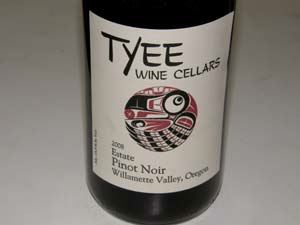 2008 Tyee Wine Cellars Estate Willamette Valley Pinot Noir 13.5% alc., 500 cases, $24. Produced from vines ranging in age from 34 years to 8 years. Pommard, 777 and 115 clones. · Moderate reddish-purple color in the glass. A charming wine in every way. Enticing aromas redolent of strawberries, raspberries and blueberries with a hint of vanilla cone. Lovely array of crisply flavored red and blue fruits with a hint of herbs. Nicely structured with ripe, firm tannins and bright acidity finishing dry and satisfying. Amazing value. Very Good.
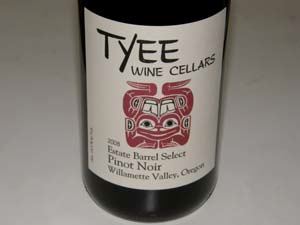 2008 Tyee Wine Cellars Estate Barrel Select Willamette Valley Pinot Noir 13.5% alc., 100 cases, $35. Produced from own-rooted old vines ranging from 20 to 34 years old (oldest plantings in the estate vineyard). Unfined and unfiltered. · Moderately light reddish-purple color in the glass. Reserved but pleasing scent of fresh cherries and raspberries with a hint of spice and rose petal. Similar flavor profile to the Estate bottling but with more intensity, more persistence, and more sophistication. The perfectly ripened fruit has a dark red profile, the dry tannins and crisp acidity frame the fruit beautifully, and the silky finish makes an lasting impression. A perfect argument for the superiority of old vine Pinot Noir. The wine was still great the following day from a previously opened and re-corked bottle, but I couldn’t report beyond this as I eagerly finished the bottle. An exceptional wine that is much more approachable than many reserve Pinot Noirs from Oregon's 2008 vintage. A vin de garde for Oregon in 2008.
Other 2008 Oregon Pinot Noirs
2008 Coelho Winery Paciência Willamette Valley Pinot Noir 12.7% alc., 1,785 cases, $35. · Moderate light dark red color in the glass. Aromas of fresh berry jam, rose petal and oak. Juicy and crisp with an interesting array of flavors including black cherry, red berry, grilled fruits, edible flowers and a hint of oak. Silky on the palate with powdery tannins. Still good the next day from a previously opened and re-corked bottle. Good (+).
2008 Domaine Serene Yamhill Cuvée Willamette Valley Pinot Noir 13.8% alc., $32. · Moderately light in color. Very ripe, even roasted berry and stone fruit aromas with accents of spicy oak. Light in weight with a red fruit profile, dominating oak tannins and an herbal oak note on the finish. A simple, tannic wine that is disappointing at this price point. Decent.
2008 Eminent Domaine Willakia Vineyard Eola-Amity Hills Pinot Noir 14.9% alc., pH 3.85, TA 0.53, 165 cases, $?. A producer in McMinnville owned by Jeff Meader focused on single vineyard Pinot Noir. Pommard and small amount of 113 clones. Aged 9 months in 29% new French oak barrels. · Moderately light in color. Aroma of black cherries and dark berries with a note of mocha. Tasty core of black cherry fruit with noticeable oak-driven flavors of mocha, char and spice. Medium-weighted and well-structured with some persistence on the generous finish. Needs cellaring. Good (+).
2008 Libra Mystic Vineyard Willamette Valley Pinot Noir 14.2% alc., 175 cases, $25. From Panther Creek Cellars. · Moderate reddish-purple color in the glass. Aromas of oak and cigar box with black and red fruits in the background. Dilute flavors of cherries and berries with plenty of oak-driven toast and mocha. Better the following day from a previously opened and re-corked bottle. Deserves a few years in the cellar. Decent.
 2008 Van Duzer Dijon Blocks Willamette Valley Pinot Noir 13.9% alc., pH 3.62, TA 0.56, $45. Dijon 828 667, 114 and 115 clones. · Moderate reddish-purple hue in the glass. Aromas of dark red berries and cherries, underbrush and subtle oak. Hi-spirited mixture of berry fruit with a nutty, earthy bent. Wellstructured with refreshing acidity and a hint of oak on the finish. Good (+).
2008 Van Duzer Westside Blocks Willamette Valley Pinot Noir 13.9% alc., pH 3.60, TA 0.58, $45. 50% Dijon 667 with smaller amounts of Pommard and Dijon 113. · Moderate reddish-purple color in the glass. The nose is closed for business. Moderately rich core of brandied black cherry, spice and anise flavors that are currently reserved and linear. Slightly better the next day from a previously opened and re-corked bottle. Warrants several years in the cellar. Good (+).
Oregon '09: Precocious and SeductiveThe 2009 Oregon Pinot Noirs might not be as appealing as the 2008 Oregon Pinot Noirs for the hard-core pinotphile, but they have found many fans among consumers. It is an early drinking vintage that will not have the aging potential of the 2008 vintage. An ideal spring led to a large fruit set but the summer was hot and in conjunction with early September rains, brought mold to some vineyards. Warm temperatures in September and October led some growers to pick late and the wines, although exuberant, showy and luscious (think Caliesque), ended up high in alcohol. The vintage was reminiscent of 2006 for some producers. One will need to tread carefully if your tastes run to more classical Oregon Pinot Noir, choosing those producers who picked earlier and cropped properly.
Antica TerraThe Antica Terra (“Old Earth” in Latin) vineyard, first planted in 1989, was purchased in 2005 by three friends and partners along with winemaker Maggie Harrison, a long time former assistant winemaker to Manfred Krankl at Sine Qua Non in Ventura, California. The 26-acre estate vineyard is situation in the Eola-Amity Hills appellation. The inaugural Willamette Valley release under Harrison was the 2006 vintage and the wines have been outstanding from the inaugural vintage. The vineyard had to be upgraded and additional plantings put in place, so about 50% of the grapes were sourced from other vineyards initially. For 2009, the following wines were scheduled for release in 2011: Willamette Valley Chardonnay and Estate Grown Pinot Noir (November 1, 2011), Erratica Rosé, Willamette Valley Pinot Noir, and the limited release Botanica (includes fruit from Shea Vineyard), the latter three April 1, 2011. The wines are sold through a mailing list with some distribution through retail channels. A new winery was completed in time for the 2009 harvest in Dundee. Vineyard tours and tasting are available by appointment (503-244-1748). The website is www.anticaterra.com.
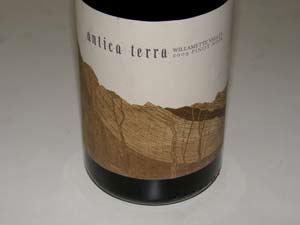 2009 Antica Terra Willamette Valley Pinot Noir 13.5% alc., $50. A blend of estate fruit with grapes from Shea, Old School, Cherry Grove, Johan and Bliss vineyards. Aged in 50% new French oak barrels. · Moderate reddish-purple color in the glass. Black cherry based aromas and flavors lashed with a noticeable oak presence of char, tobacco and coffee, but offering nuances of earth and grilled mushrooms. Creamy and silky, with firm but supple tannins, and a pleasing aromatic finish. Better the next day from a previously opened and re-corked bottle. Will benefit from time in the cellar. Good (+).
Lenné EstateSee description under first feature in this issue. Owner Steve Lutz says the 2009 vintage wines should be consumed within 4 to 5 years. The 2009 wines have higher alcohols, less intensity of flavor, and are more forward than their 2008 brethren. That said, these are very nice wines to drink while you wait for the 2008s to mature. The higher alcohols do not intrude unless the wines are allowed to warm to room temperature.
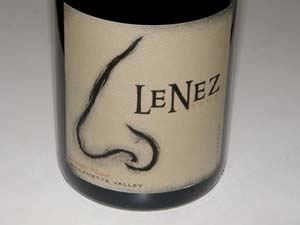 2009 Lenné Estate Le Nez Willamette Valley Pinot Noir 14.8% alc., $30. Entirely estate fruit with same yields as Lenné Estate Pinot Noir. All five clones planted at Lenné. · Moderately light reddish-purple color in the glass. Aromas of spiced dark red berries and cherries with a slight roasted character and a hint of old book. Discreetly concentrated core of dark red berries with underpinnings of anise and Asian 5-spice. Welcoming elegance, ending with a trace of heat. Good.
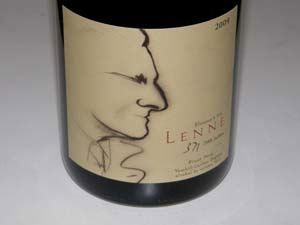 2009 Lenné Estate Yamhill-Carlton District Pinot Noir 14.8% alc., $45. A selection of best barrels and primarily clones 115 and Pommard. · Moderately light reddish-purple color in the glass. Highly aromatic with notes of dark red cherries and raspberries, baking spices and sandalwood. Crisp and juicy flavors which mimic the aromas. Not the intensity of the 2008 vintage, but more approachable and currently very satisfying. Nicely crafted. Very Good (+).
2009 Lenné Estate Kill Hill Yamhill-Carlton District Pinot Noir 15.4% alc., 49 cases, $55. From the most stressed portion of the vineyard with shallow, nutrient poor soil. Clone 667. · Moderately light reddish-purple color in the glass. Subdued nose with reticent aromas of dark red fruits, mushrooms and wet earth. Well-endowed and noticeably rich with flavors of dark strawberries, dark raspberries, and a kick of citrus on the finish. Smoothly textured with firm but supple tannins. A ripe, big gulp of Pinot in a Caliesque style. Will have fans. Good (+).
2009 Lenné Estate Jill’s 115 Yamhill-Carlton District Pinot Noir 14.8% alc., 49 cases, $55. · Lightly colored in the glass. Subdued aromas of crushed red berries and baking spices. Elegantly crafted with charming flavors of dark red cherries and berries, sassafras and a slight candied, even cotton candy tone. Soft, supple tannins make for easy drinking. Very Good (-).
 2009 Lenné Estate Eleanor’s Vineyard Yamhill-Carlton District Pinot Noir 15.4% alc., 49 cases, $55. First bottling of 114 clone. · Moderately light reddish-purple color in the glass. Enjoyable perfume of delicate red fruits. Red-fruited with hints of savory oak, spice and dark chocolate, with an appealing velvety mouth feel. Elegantly styled and easily approachable. Leaves a little heat in its wake on the finish. Good (+).
Luminous & Seven of HeartsThese wines are the work of Byron Dooley, who, along with his spouse Dana, escaped from Silicon Valley during the internet bubble of 2000. Arriving in Napa Valley, Byron earned his viticulture and winemaking degree at Napa Valley College. After an internship at Williams Selyem, he made his own Bordeaux-styled wine from Napa fruit. In 2004, the couple acquired a property in the Yamhill-Carlton District and developed a 11.2- acre estate vineyard named Luminous Hills. Two labels were started: Seven of Hearts and Luminous Hills. Dana opened Honest Chocolates in McMinnville selling traditional style chocolates. Later, a second branch was opened in Carlton which shares space with the Seven of Hearts and Luminous Hills Tasting Room. Seven of Hearts is about exploring vineyards in Oregon’s Willamette Valley and neighboring regions, featuring distinct appellations and in some cases, unique vineyards, as well as other varieties along with Pinot Noir. The label’s neoclassical elements symbolizes the winery’s passion for the traditional Burgundian style of Pinot Noir. Wines from the estate vineyard are vinified under the Luminous Hills label. The vineyard is a unique high elevation site with both sedimentary and volcanic soils. The planted clones are Dijon 115, 667 and 777, and Pommard. The vineyard is dry-farmed and a participant in the L.I.V.E. sustainability program. Three wines are produced from the Luminous Hills Vineyard: a Yamhill-Carlton District Estate Grown Pinot Noir, the LUX Pinot Noir (777 and Pommard selection) and the ASTRA Pinot Noir (100% whole cluster 667, 60% 667 and 777 partially whole cluster fermented in a supporting role). Luminous Hills is unique for the two delineated soil types and diversity of terrain. The vineyard is divided into distinct blocks based on elevation, soil type and clones planted. The goal is to create distinct wines that highlight the differences in the different blocks of the vineyard. The Estate Grown bottling uses a broad selection from the vineyard. LUX is a smaller production wine largely based on Pommard grown on sedimentary soil. Whole cluster is about 50% in this wine, largely from one of the lots of Pommard that was 100% whole cluster fermented in combination with some partially whole cluster fermented 777. The ASTRA, which was launched in the 2009 vintage, is marked by the high percentage of 667 that is whole cluster fermented. Byron calls the LUX more voluptuous, ASTRA more radiant. The layout of the Luminous Hills Vineyard blocks is depicted below:
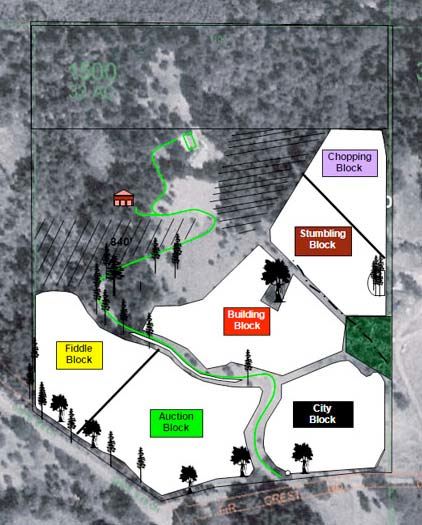 The winemaking approach for Seven of Hearts and Luminous Hills is the same using traditional methods such as native yeast fermentation, whole cluster fermentation when appropriate, minimal handling and additions, and largely no fining or filtering. Varietals that are classically grown in France are featured under the Chatte d’Avignon sub-label of Seven of Hearts. Seven of Hearts wines (www.sevenofheartswine) and Luminous Hills wines (www.luminoushills.com) are sold on the respective websites. The owners sum up their goal as follows: “We want to make accessible (meaning both affordable and approachable) wines that are genuine expressions of different varietals, where they are from, and the conditions under which they were grown; wines with complexity, purity and elegance.”
2009 Seven of Hearts Willamette Valley Pinot Noir 13.8% alc., 630 cases, $20. Released February 1, 2011 via tap program in Portland restaurants, May 1, 2011 in bottles. Sourced from five vineyards in three appellations. Pommard, Wädenswil, 777, 667 and 115 clones. 12% whole cluster, native yeast fermentation, 23% new French oak barrels, unfined and unfiltered. · Moderately light reddish-purple color in the glass. Hint of volatile acidity which lessens over time. Scent of spiced red berries and a hint of new oak. Flavors of red strawberries and cranberries and cherries with savory herbs. Bright acidity and mild tannins. A daily drinker. Decent.
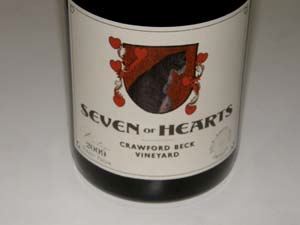 2009 Seven of Hearts Crawford Beck Vineyard Eola-Amity Hills Pinot Noir 14.5% alc., 98 cases, $35.Released May 1, 2011. 100% clone 115 from a single vineyard with volcanic soils. Native yeast fermentation, aged in 23% new French oak barrels, unfined and unfiltered. · Moderate reddish-purple color in the glass. Aromas of dark red fruits including strawberries, polished wood and cut flowers. Tasty essence of darker red berries and cherries with a subtle note of anise and a riff of citrus peel on the finish. Soft in the mouth with supple tannins and bright acidity at the end. Good.
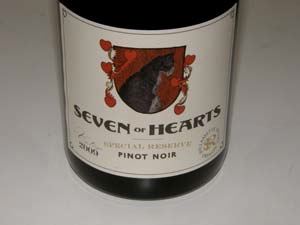 2009 Seven of Hearts Special Reserve Willamette Valley Pinot Noir 14.0% alc., 147 cases, $42. Released May 1, 2011. From four vineyards in three appellations (including Luminous Hills) and both volcanic and sedimentary soils. Clones 114, 115, 667, 777, Pommard and Wädenswil. 33% whole cluster fermentation, native yeast fermentation, aged in 23% new French oak barrels, unfined and unfiltered. · Moderately light reddish-purple color in the glass. Nice array of aromas including fresh cherries, red currants, spice and a hint of vanilla. Cherry pie filling is the theme with crisp acidity, firm tannins and a lingering presence of perfectly ripe fruit on the finish. Very ephemeral in the mouth. Very Good.
2009 Luminous Hills Estate Grown Yamhill-Carlton District Pinot Noir 15.0% alc., 357 cases, $28. Released February 24, 2011. Clones 667 from higher elevation volcanic Jory soils on the site and 115 and Pommard clones from the lower elevation sedimentary sites. 20% whole cluster fermentation (including 100% whole cluster Pommard), native yeast fermentation, aged in 23% new French oak barrels, unfined and unfiltered. · Moderately light reddish-purple color in the glass. Aromas of summer red fruits with hints of cedar and rose bouquet. Light on its feet, with tasty red berry and cherry flavors, complimentary oak highlights, and an aromatically floral finish. A discreetly composed and charming wine. Very Good.
 2009 Luminous Hills Estate Grown Yamhill-Carlton District ASTRA Pinot Noir 15.0% alc., 98 cases, $35. Released May 1, 2011. Released February 24,, 2011. 60% clone 667 from higher elevation volcanic soils and 40% 115 from lower elevation sedimentary soils. 60% whole cluster, native yeast fermentation, aged in 23% new French oak barrels, unfined and unfiltered. · Moderately light reddish purple hue in the glass. Very shy nose with demure aromas of red stone fruits and spice. A carnival of charming black cherry and black raspberry fruit floods the palate and brings it to attention. This is one of those wines that you taste and then just look at the glass, astonished that such flavor could originate from the liquid in the glass. Clean and polished with an ephemeral presence, ending with a generously fruity finish that leaves a touch of heat in its wake.
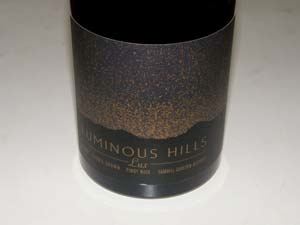 2009 Luminous Hills Estate Grown Yamhill-Carlton District LUX Pinot Noir 15.0% alc., 147cases, $35. Released February 24, 2011. Primarily Pommard clone from the lower elevation sedimentary soils (66%) with 777 from the higher elevation volcanic soils in a supporting role (33%). 50% whole cluster fermentation, aged in 23% new French oak barrels, unfined and unfiltered. · Moderately light reddish-purple color in the glass. Flamboyant aromas of fresh red berries with Asian 5-spice. Well-endowed flavors of dark red cherries and berries with a firm tannic backbone. Similar to the ASTRA but more darkly fruited. Impressive persistence on the memorable finish. Despite the high alcohol, the fruit is neither over ripe or roasted in character. Very Good (+).
2009 Kosta Browne: Bombs Bursting In Your MouthHas there ever been another California Pinot Noir producer to so quickly captivate the wine buying public? The story is now familiar. Two friends, Michael Browne and Dan Kosta, met while working at John Ash and Co. restaurant in Santa Rosa and decided to save their tip money to make wine. In 1999 they produced 2,600 cases of Lake County Sauvignon Blanc, an extremely unrewarding financial mistake. By 2001 they had teamed with Chris Costello and his family who provided a fiscally conservative and thoughtful business plan. The 2003 wines crafted by Michael Browne were highly regarded by noted wine critic James Laube of the Wine Spectator who gave the wines scores ranging from 90 to 96. The mailing list quickly filled up and Kosta Browne Pinot Noir was soon on every pinotphile’s radar. In 2009, the winery was sold to the investment group Vincraft for a reported $40 million. Dan Kosta, Chris Costello and Michael Browne continue as minority partners and remain at the winery in their current sales and marketing, management, and winemaker roles respectively. In 2011 plans were announced to build a new modern winery in downtown Sebastopol, the first bonded winery within the city limits. The former Barlow Apple Factory is being reinvented to feature both production and retail for artisan wine as well as food purveyors and artists. Kosta Browne will double its space, from 18,000 square feet to 45,000 square feet. Production (about 14,000 cases) will remain nearly the same and although the winery is in a more public location, there is no plan to open a tasting room. Tasting is by appointment for mailing list members (there is currently a waiting list). I believe Kosta Browne’s rapid road to success stems from three sources. First, Dan and Michael are extremely congenial and customer service oriented, they are well-liked by the wine community, and they are willing to support many fund-raising charity activities. Second, the partners were able to use their longstanding friendships and contacts to source from top growers in the Russian River Valley, Sonoma Coast and Santa Lucia Highlands appellations. Like Williams Selyem who preceded them and established the model, they sought out premium vineyards that met their stringent standards for quality. In the most recent Kosta Browne newsletter, Michael says, “The most important thing I have learned about crafting wine over the years is how crucial it is to have the best fruit sources available to supply us with the raw product necessary to produce top quality wines.” Third, Michael Browne knows how to make Pinot Noir in a New World hedonistic style that appeals to a broad audience of wine lovers. As Michael has noted, “Wine is enjoyed much like music, and I like Rock ‘n Roll.” I asked Michael to give me his thoughts on the 2009 vintage. “2009 was pretty much an ideal growing year. Warm temperatures but very few heat spikes. The vines were in great balance both in the canopy and the fruit load. The clusters were similar in size to 2007: mainly small hand grenade sized clusters with uniformly sized, small berries. We did not need to do too many extra procedures in the vineyard (compared to 2008) as Mother Nature did most of the work, delivering just what the vines needed. We did get most of our fruit in a short amount of time which was a challenge. Fortunately, we had the crew and capacity to handle it.” “The resulting wines are intense but not too intense. The aromatics and flavors are of ripe fruit, not over ripe and not under ripe. Fresh, ripe, intense raspberry and strawberry off the plant for example rather than stewed, preserve style berries or light flavored berries. Same goes for the cherry, rhubarb, cranberry and pomegranate flavors and aromas in some of the wines. Peak of ripeness comes to mind. The wines, although all in the Kosta Browne style, show a unique and distinctive character which is driven by the region or by the vineyard. This is what we have been trying to do for some time. The wines at this point are intense with fruit, but will relax and come into very good balance in 3 to 5 years and beyond.” “In comparison, the 2007 vintage is a bit more tight. I love the wines but they need to age longer. The 2007s have great balance and are very well put together but they do need time for the soul to completely break out. The 2008 vintage is alive and well at this stage although these wines will age as well. The 2008s have fresh fruit components and are very expansive with lots of energy. I think the 2009 wines are a cross between the 2007 and 2008 vintages. They have the serious side of the 2007s and the playful side of the 2008s. Great combination. 2010 is shaping up well considering the challenging time with Mother Nature. Similar in intensity to 2009 with more of a broad texture. The pH levels are slightly higher which I believe is leading to the more broad texture.” In the most recent Kosta Browne newsletter, Michael makes the following remarks. “The resulting wines (referring to the 2009s) could be our best to date. I know I say this every year, but I do feel these wines are at the top of what we have ever produced. Upon completing our blended 2009 wines, we tasted them alongside the 2007 and 2008 wines. The 2009s revealed their intensity, fresh fruit aromatics and flavors, along with expansive red and black fruit character that starts at the top of the tongue, saturating the sides and top of the palate and melting down around the entire palate with a persistent and lingering finish. Although all the wines are unique in character, they all show this attribute: a beautiful fingerprint and delicious vintage!” Kudos also go out to the team of exceptional winemakers at Kosta Browne: Shane Finley is the lead winemaker who has been at Kosta Browne for five years. Ryan O’Donnell has been a member of the winemaking staff since 2007. Pete Soergel was a key part of the staff for three years in the role of cellarmaster and has now moved on to assistant winemaker at Landmark Winery. Michael Browne below.
 I concur with Michael that only sexual analogies can do the 2009s justice. The wines are packed with sweet fruit but have the tannin structure and alcohol backbone to handle it. Currently, the fruit in the wines is nearly overwhelming, but by the time the wines are released and consumers get their hands on the wines they should be a little more balanced. The wines can be enjoyed now for their hedonistic spirit, but will benefit from cellaring for a year or two. I would guess the wines will drink best in two to four years and plateau for a several years beyond that. Do not overlook the appellation wines as they are very impressive in this vintage. Total production in 2009 was about 14,000 cases including a Chardonnay for the first time. Magnums and larger formats are never sold and reserved for charity auctions and special events.
2009 Kosta Browne Russian River Valley Pinot Noir 14.6% alc., 4,320 cases, $52. · Darkly colored in the glass. Highly perfumed with aromas of Bing cherries, cola and spice. Flush with cherry pie filling flavor complimented by spicy oak and rounded out with supporting ripe tannins. Finishes with impressive persistence. A fine representation of the Russian River Valley AVA. Uncomplicated but irresistible. Very Good.
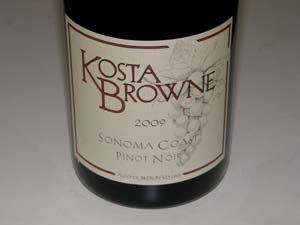 2009 Kosta Browne Sonoma Coast Pinot Noir 14.5% alc., 5,818 cases, $52. Sourced from three vineyards: Gap's Crown, Terra de Promissio, and Walala. The wine was aged about 12 months in oak before release in early 2011. Wine Spectator #1 Wine of Year for 2011. · Moderately dark reddish-color in the glass. Charming and fruity on the nose which is redolent with aromas of black cherries and black raspberries with an accent of spice cabinet. Fades a bit in the glass over time. Delicious and lush core of black plum and blackberry fruit with a subtle savory herb note in the background. Richly endowed but nicely balanced by ripe tannins and lively acidity, and offering an attractive creamy mouth feel. The generous finish has very good length. Still good the next day from a previously opened and re-corked bottle. Very Good.
2009 Kosta Browne Gap’s Crown Vineyard Sonoma Coast Pinot Noir 14.5% alc., 148 cases, $72. · Moderately dark reddish-purple hue in the glass. Nicely perfumed with scents of dark cherries and raspberries, spice and rose petals. Moderately intense flavors of plum sauce and black raspberries with an earthy underpinning, finishing with some oak and pomegranate highlights. Mild, supple tannins, bright acidity and some persistence on the finish. A solid wine, but just doesn’t deliver the flavor interest for me. Good (+).
2009 Kosta Browne Rosella’s Vineyard Santa Lucia Highlands Pinot Noir 14.8% alc., 272 cases, $72. · Moderate reddish-purple color in the glass. Perfumed with aromas of spice dark red fruits, wilted roses, hard red candy and redwood. Discreetly concentrated flavors of red cherries, pomegranates, brown spice and graham. Soft in the mouth and lighter weighted than the other Santa Lucia Highlands offerings. A bit exotic and unusual in its flavor profile and quite different from the 08 version. Good (+).
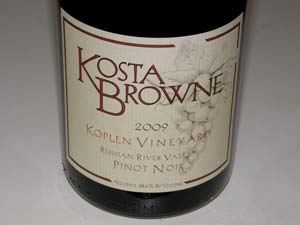 2009 Kosta Browne Koplen Vineyard Russian River Valley Pinot Noir 14.6% alc., 678 cases, $72. · Deep, dark reddish-purple color in the glass. Scents of black cherries and berries with hints of oak, cedar and spice. Intense mid palate explosion of blackberry, ollaliberry, and black cherry. Herbal accents keep the wine savory. A palate staining, lush wine that is well framed by ripe tannins and bright acidity, finishing with a Hollywood ending (dramatic and memorable). Off the charts fruit intensity! Very Good.

2009 Kosta Browne Pisoni Vineyard Santa Lucia Highlands Pinot Noir 14.8% alc., 142 cases, $72. · Moderately dark reddish-purple color in the glass. Subdued aromas of dark red and black fruits with a hint of seasoned oak. Discreetly concentrated array of dark red fruits which are monolithic at present but suggest an intensity waiting to get out. Smoothly textured with firm but supple tannins for aging. Hard to judge this wine at this stage as it has a long way to go to reveal itself, but I predict greatness over time. Patience advised. Very Good.
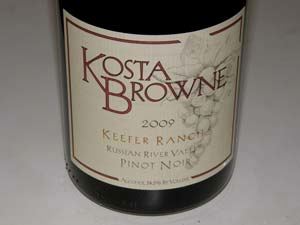 2009 Kosta Browne Keefer Ranch Russian River Valley Pinot Noir 14.5% alc., 816 cases, $72. · Reddish-purple hue in the glass. Lovely scent of just picked red cherries and red berries, baking spices and sandalwood. Bright and juicy flavors of spiced red cherries with a savory herbal note on the finish. The most demure of the 2009 wines with plenty of charm and elegance and a refreshing riff of acidity running through. Offers a clear sense of cool Green Valley terroir. Very Good (+).

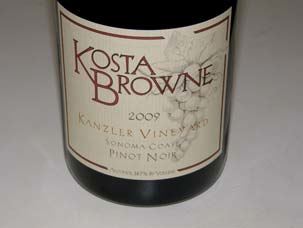 2009 Kosta Browne Kanzler Vineyard Sonoma Coast Pinot Noir 14.7% alc., 575 cases, $72. · Moderate reddish-purple color in the glass. Very interesting nose offering scents of fresh berries, underbrush, forest floor, spice, rose petal and brioche. Bright and charming with a tasty essence of Rainer cherry and dark red raspberry with a hint of exotic spice. Every sip reveals another nuance. Medium weighted with soft tannins and bright acidity. An elegant bent for Kanzler in this vintage that is stunning. Built for the long haul.
2009 Kosta Browne Garys’ Vineyard Santa Lucia Highlands Pinot Noir 14.7% alc., 439 cases, $72. · Dark and dense reddish-purple color in the glass. Reserved but pleasing aromas of black stone fruits with complimentary oak spice and anise. Rich, full, sweet and beautifully composed black plum and blackberry flavors that offer real density and a mouth coating finish of unbelievable persistence. Fruit-driven and primary now, but the gorgeous fruit is impossible to ignore. Similar to the Pisoni in flavor profile but more giving now. I have never tasted anything so sensual from this vineyard. Wowzaa!
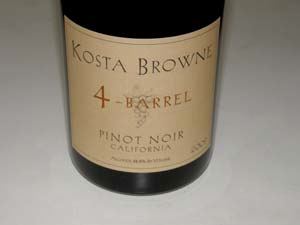 2009 Kosta Browne 4-Barrel California Pinot Noir 14.8% alc., 91 cases, $72. · Moderate reddish-purple color in the glass. Slow to emerge in the glass but the sophistication is evident. Aromas of berry jam on toast with a pleasing hint of spice and oak. Intense core of big cherries and ripe plums that coat every nook and cranny in the mouth. Polished and round with a soft finish that won’t let go. This wine is relatively closed now but the potential is obvious. Better the next day from a previously opened and re-corked bottle. The lucky few who get this wine are in store for a treat.
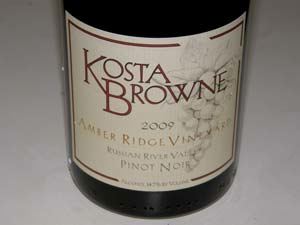 2009 Kosta Browne Amber Ridge Vineyard Russian River Valley Pinot Noir 14.7% alc., 423 cases, $72. · Dark reddish-purple color in the glass. Enticing and long aromas of black cherries with hints of warm brioche. Delicious and lush on the palate with expressive flavors of big, ripe cherries and the freshest raspberries, growing more vivid in the mouth over time. Complimentary notes of baking spice add interest. Very polished in the mouth with peach-skin tannins and a texture that is soft as the hair on an angel. Pin point balance, regal presence, and just plain great.
Arista Winery: Now A Member of the Westside Road EliteThe Westside Road Pinot Noir blue bloods, including Rochioli Vineyards & Winery, Williams Selyem and Gary Farrell Winery, have been joined in recent years by upstarts, Arista Winery, Twomey and Thomas George Estates, who are producing wines that now rival those of the established elite. The 2009 Pinot Noirs crafted at Arista Winery are clearly in the upper echelon of this prestigious group.
 Al (an orthodontist) and Janis Copeland McWilliams along with Al’s brother-in-law, John Copeland, purchased a family vineyard estate in 1996 called Pine Mountain Vineyards in Cloverdale. Over time, the McWilliams family developed an interest in producing their own wine. In 2004, Al and Janis acquired 36 acres of prime viticultural land on Westside Road in Healdsburg with the idea of producing their own wine. The Russian River Valley became the home of Arista Winery and its estate Pinot Noir vineyards, as well as a home for the McWilliams family. The property is adjacent the Williams Selyem Estate Vineyard and the Baker Ridge Vineyard of Thomas George Estates. Arista originally focused on producing Russian River Valley Pinot Noir, but their reach has now extended to sourcing fruit from the Sonoma Coast, Anderson Valley, Mendocino Ridge and Santa Cruz Mountains appellations. Ten acres of Pinot Noir are planted on the estate and the first wines from here are just now being previewed. Arista’s vineyard manager, Ulises Valdez, assisted in the planting and farming of the estate vineyard and directs the farming of several of Arista’s non-estate sites. Arista is a family affair with son Mark managing the day to day operations at the winery as well as assisting with the winemaking duties. Another son, Ben oversees the mailing list and works with special events and hospitality. The winery Maltese dog, Lucy, has been published in several winery dog books. Winemaker Leslie Sisneros brings a wealth of experience to Arista. She received her degree in viticulture from University of California Davis and subsequently worked at Rodney Strong, Chateau St. Jean, Haywood and John Culbertson Wines. She joined Kendall Jackson Winery in 1993 when Vinwood was acquired and rose to Assistant Winemaker in charge of operations and Flavor Winemaker for Pinot Noir. At Kendall Jackson she crafted four tiers of Pinot Noir varying from 48 to 120,000 cases, focusing on cool climate vineyards of the Russian River Valley, Anderson Valley, Monterey County and Santa Maria Valley. I tasted many of the Arista 2009 fall 2011 releases at the winery with Leslie and Mark and recently had the opportunity to taste the spring and fall release 2009 wines in depth after some bottle age. The style is elegant with soft textures, delicate use of oak with new oak usage matched to the fruit, bright acidity and long finishes. The wines are inoculated at fermentation and include small amounts of whole cluster. The ultimate goal is to bring out the uniqueness and full potential of each vineyard in the many single vineyard bottlings. My tasting indicated that they have clearly accomplished that goal. The appellation wines are not to be ignored, however, for they are superb in their own right. There is impressive consistency over the entire range of 2009 Pinot Noirs offered. Arista wines are sold primarily through a mailing list with some retail distribution of the larger production wines. Some wines are sold through the website. The best way to acquire the small production wines is to add your name to the “A List.” This allocation list is unfortunately closed at this time, but you can join the waiting list. Alisters can buy wines before the general public and are invited to special winery events. The winery also offers Zinfandel, Pinot Gris and Gewürztraminer. The tasting room is surrounded by a serene Japanese garden and is open daily from 11:00 to 5:00. Tours are available by appointment (707-473-0606). Visit the website at www.aristawinery.com. for more information.
2009 Arista Russian River Valley Pinot Noir 14.3% alc., pH 3.84, TA .56, 739 cases, $44. Released spring 2011. Aged in 6% new, 15% 1-year-old and 79% 2-3-year-old French oak barrels. · Moderate reddish-purple color in the glass. Lovely perfume of black cherries, black raspberries, spice, rose petal and stem leading to a moderately rich core of black cherry fruit with a slight oaky, earthy bent. The tannins are slippery and the wine is soft in the mouth. Doesn’t excite, but grows on you over time in the glass. Good.
2009 Arista Sonoma Coast Pinot Noir 14.3% alc., pH 3.73, TA .65, 265 cases, $34. Released spring 2011. Aged in 16% new, 25& 1-year-old and 59% 2-3-year-old French oak barrels. · Moderately light in color in the glass. Fresh aromas of red berries and plums, forest floor and oak cask. Very easy drinking with tasty array of bright red Pinot fruits and a hint of spice and mocha. The tannins are supple, there is a lively grip of acidity, and the seamless texture delivers considerable appeal. Good (+).
2009 Arista Mendocino Ridge Pinot Noir 14.3% alc., pH 3.75, TA .59, 277 cases, $38. Released spring 2011. Sourced from Perli Vineyard. Aged in 40% new, 17% 1-year-old and 43% 2-3-year-old French oak barrels. · Moderate reddish-purple color in the glass with a slight cloudy haze. Plenty of dark red stone fruits on the hi-tone nose with hints of summer herbs and spice. In the mouth, the lithe and seductive array of blue and dark red fruit is delicious augmented by a satiny mouth feel, supple tannins and a discreetly fruity and long lasting finish. Similar to the Perli Vineyard bottling (both wines are from this source) but lacks some of its nuance and exoticism. Very Good.
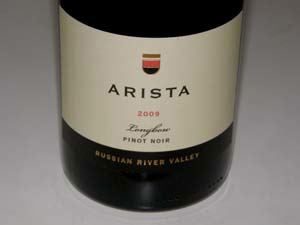 2009 Arista “Longbow” Russian River Valley Pinot Noir 14.3% alc., pH 3.75, TA .53, 493 cases, $48. Released spring 2011. Aged in 41% new, 18% 1-year-old and 41% 2-3-year-old French oak barrels. · Darkly colored. A thoroughly enjoyable wine that is distinct among the Arista lineup for its richness of fruit. Aromas of blackberries and cassis, brown spice, anise and old oak cask. Moderately dense and mouth coating flavors of black plums and blackberries with complimentary underpinnings of savory herbs and oak in the background. A fruit-centric wine that retains finesse and agility and is thoroughly enjoyable for its muscular style.
2009 Aristra La Cruz Vineyard Sonoma Coast Pinot Noir 14.2% alc., pH 3.75, TA .56, 318 cases, $52. Released spring 2011. From Keller Estates La Cruz Vineyard in the Petaluma Gap. Aged in 15% new, 39% 1- year-old, and 46% 2-3-year-old French oak barrels. · Dark reddish-purple robe. Shy, but attractive perfume of darker berries, spice and oak picking up interest over time in the glass leading to flavors that reflect the nose. The wine offers a juicy, crisp mouth feel, supple tannins, and impressive persistence on the highly aromatic finish. Beautifully balanced and very charming. Very Good (+).
2009 Arista Bacigalupi Vineyard Russian River Valley Pinot Noir 14.3% alc., pH 3.82, TA .52, 106 cases, $58. Released spring 2011. Plantings date from the early 1960s with cuttings from Carl Wente in the Livermore Valley. 2 tons of old Wente Selection and 2 tons of Pommard clone Pinot Noir. Aged in 17% new, 33% 1-year-old, and 50% 2-3-year-old French oak barrels. · Moderately light reddish-purple color in the glass. Haunting aromas of cherry pie filling, damp earth and stem. As typical with this vineyard, the cherry fruit has a mild herbal, tar and tobacco riff. Soft and elegant in the mouth with fine-grain powdery tannins. A unique expression of Russian River Valley Pinot Noir. Good (+).
2009 Arista Woodruff Vineyard Santa Cruz Mountains Pinot Noir 14.1% alc., pH 3.65, TA .57, 60 cases, $55. Released summer 2011. A one-time bottling. This vineyard is located in Corralitos, five miles inland from Monterey Bay and adjacent Windy Oaks Vineyard. Originally known as the Matteson Vineyard, it was planted in 1978 to a now forgotten selection of Pinot Noir. Peter and Barbara Woodruff acquired the vineyard in 2001 and dedicated themselves to preserving this venerable vineyard. Own-rooted. Yields are about .75 tons per acre. Aged in 33% new and 67% 2-3-year-old French oak barrels. · Moderate reddish-purple color in the glass. Lovely aromas of black cherries and black raspberries initially, fading a bit to reveal notes of exotic spices, stem and rose petals. The wine features layered darker fruits, particularly black cherries, that are modest in concentration with an oak influence that tends to fade over time in the glass. Nicely balanced with supple tannins and a velvety mouth feel. Doesn’t emote, but grows on you over time in the glass. Needs more time to come together. Good (+).
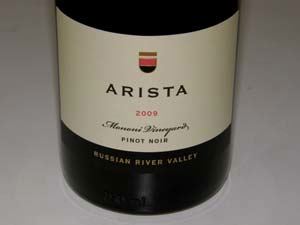 2009 Arista Mononi Vineyard Russian River Valley Pinot Noir 14.3% alc., pH 3.72, TA .55, 310 cases, $60. Released summer 2011. Located at the intersection of Olivet Lane and River Road, this 10-year-old vineyard was planted to Dijon clones 113 and 115 which perform well at this very cool site. Aged in 38% new, 23% 1-year-old and 38% 2-3-yearold French oak barrels. · Lightly colored in the glass. I couldn’t quit smelling this wine with its gorgeous aromas of black cherry pie filling. Discreetly concentrated and cherry-driven with added flavor nuances of baking spices, savory herbs and oak. Velvety smooth and elegant with welcoming restraint. A complete wine that is beautifully crafted.
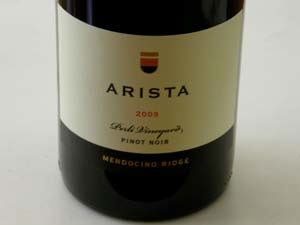 2009 Arista Perli Vineyard Mendocino Ridge Pinot Noir 14.3% alc., pH 3.75, TA .59, 177 cases, $52. Released summer 2011. This vineyard was planted in 2003 and is owned and farmed by Steve Alden. Located at 2300 feet above the maritime fog line and about 6 miles inland. A narrow diurnal swing means the grapes never fully shut down. Yields are very small. Clones 667 and 777. Aged in 25% new, 25% 1-year-old and 50% 2-3-year-old French oak barrels. · This wine is a perfect example of why there is so much buzz about this relative new appellation for Pinot Noir. Moderate reddish-purple color in the glass. A plethora of dark red berry fruit dominates the nose with lesser contributions of baking spices and sandalwood. The judiciously intense blue and dark red fruit has a wild, exotic quality that sneaks up on you and demands your interest as nuances appear over time. It reminds of gazing afar at a beautiful woman in a classy dress. Once you get up close, you notice the beading, embroidery and touch of lace. A very distinctive hi-collared Pinot Noir.
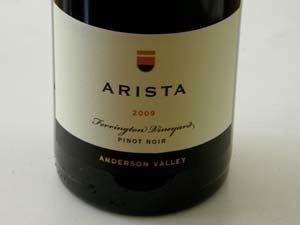 2009 Arista Ferrington Vineyard Anderson Valley Pinot Noir 14.1% alc., pH 3.56, TA .62, 213 cases, $56. Released summer 2011. Tucked away off of Highway 128 in Boonville, this 25-acre site is planted to multiple clones of Pinot Noir. Originally planted in the late 1960s, additional plantings occurred in 1998 and more recently. This wine is 100% Pommard clone. Aged in 44% new, 22% 1-year-old and 34% 2-3- year-old French oak barrels. · While the Perli Vineyard Pinot Noir seduces you, the Ferrington Vineyard Pinot Noir overwhelms you. Moderate reddish-purple color in the glass. Nicely composed aromas of black raspberries and blackberries touched by oak and loam picking up interest over time in the glass. Endowed with rich tasting earthy black plum and blackberry fruit wrapped in supple tannins. The wine grabs hold of the mid palate, surrounds it and refuses to let go, before finally conceding to a Grand Cru ending that is like a three-hour movie you don't want to end. A beautiful representation of this distinguished vineyard.
2009 Arista Hawk’s View Vineyard Chehalem Mountains Willamette Valley Pinot Noir 220 cases. From own-rooted vines planted in the early 1990s owned and farmed by the Kemp family. Clones 115 and 2A. · Crisp and clean with bright berry aromas and flavors, supple tannins and good integration of oak. Finishes with hitone acidity.
2009 Arista Two Birds Vineyard Estate Russian River Valley Pinot Noir First harvest from the estate vineyard. · Alluring aromas of Bing cherries which pick up intensity with swirling. Intense and fruit-driven with a rich core of cherry fruit, prominent cola flavor, brown spices and notable tannin. Typical of a young vine Pinot.
More Princely Pinots
Two recent releases are reviewed from this consistently excellent producer located in Elk high above the Anderson Valley. Jason Drew acquired his 26-acre ridge top property in 2005 and built a winery and home on the property. Planting of Pinot Noir started this year. Grapes are currently sourced from the Sonoma Coast, Anderson Valley, Yorkville Highlands and Mendocino Ridge. A tasting room is open Thurs-Mon 11:00-5:00 at 9000 Highway 128 in Philo, just north of the Goldeneye Winery. The tasting room is shared with several other notable producers. The associated “The Madrones” has two private guest quarters for rent; ideal for those wishing to spend some time in the Anderson Valley and explore the wines of the region. Drew wines are primarily sold through a mailing list. Visit www.drewwines.com. Jason and Molly Drew below.
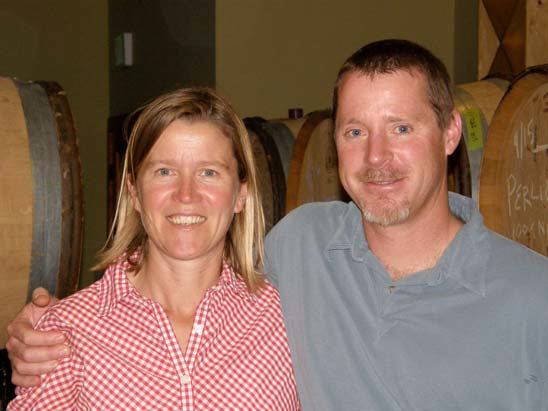
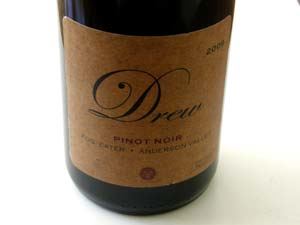 2009 Drew Fog-Eater Anderson Valley Pinot Noir 13.6% alc., 370 cases, $40. From two organically farmed sites: 60% Balo Vineyard and 40% Monument Tree Vineyard. Fog-Eater is a regional Boontling term used by the early settlers of the Anderson Valley. This pejorative term is used to describe a coastal dweller, someone living on the margin. · Moderate reddish-purple color in the glass. Highly aromatic with scents of dark stone fruits and berries with hints of spice and floral bouquet picking up interest and intensity over time in the glass. Medium weighted flavors of plum sauce and dark berry jam with a grip of Asian spice and shaved oak. Perfectly balanced supple tannins and juicy acidity. Ready to drink now and over the short term. I really enjoyed the freshness of this wine.
2009 Drew Valenti Vineyard Mendocino Ridge Pinot Noir 13.4% alc., 72 cases, $40. This vineyard is located on the top of Greenwood Ridge, 6 miles from the ocean at 1,400 feet above sea level. It is a challenging site with daily maritime winds resulting in very cool temperatures throughout the growing season. The marginally fertile topsoil overlays a deep profile of sandstone and shale which roots can penetrate deeply to take up water and minerals enabling a dry farming situation. Daytime temperatures are typically 7 to 10 degrees cooler than the Anderson Valley floor. Yields are very low. · Deep purple color in the glass. Very reluctant nose offering little fruit and primarily oak. Admirable richness and intensity of fruit flavor offering a rainbow of dark fruits including black cherries, black plums and cassis. Still tight with oak and tannin in evidence. Set this aside in your cellar while you drink the Fog-Eater. Could be a wine to contemplate down the road. Very Good.
Flying Goat Cellars A humorous name but a serious winery. Veteran Santa Barbara County winemaker Norm Yost produces small lots of Pinot Noir, Pinot Gris and sparkling wine from vineyards in Santa Barbara County and San Luis Obispo County. He is a true garagiste with a small winery in the Lompoc “wine ghetto.” A graduate of University of California Davis Enology and Viticulture program, Norm developed his winemaking skills in Napa Valley, Oregon and Australia before his love for Pinot Noir led him to Santa Barbara County. The first Flying Goat crush was in 2000. The name of the winery derives from his two pygmy goat pets. Pinot Noir is sourced from Rio Vista Vineyard and Rancho Santa Rosa Vineyard in the Sta. Rita Hills, Dierberg Vineyard and Solomon Hills Vineyard in the Santa Maria Valley, and the Salisbury Vineyard in San Luis Obispo County. The clone 23 Pinot Noir for his sparkling wine is from Solomon Hills Vineyard. Tasting is available in the “Goat Shed” winery Thurs -Sun (but call ahead to insure Norm is in town). The wines are largely sold through a mailing list. Visit the website at www.flyinggoatcellars.com or www.sbwinestore.com for availability. Saturday, August 20, Flying Goat Cellars is hosting its annual Rio Vista Vineyard Picnic and Tour. Meet at Lompoc Wine Ghetto, 1520 East Chestnut Court, take a chartered bus to the vineyard while enjoying the 2009 Goat Bubbles Blanc de Blancs. At the vineyard taste Flying Goat wines, tour the vineyard and enjoy a picnic lunch. Cost is $40 plus tax per person. For tickets, call Kate at 805-736-9032 or email info@flyinggoatcellars.com.
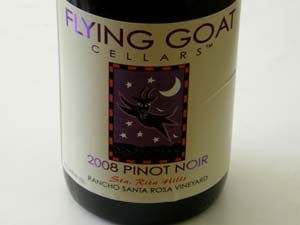 2008 Flying Goat Rancho Santa Rosa Vineyard Sta. Rita Hills Pinot Noir 14.8% alc., pH 3.69, TA 0.65, 103 cases, $46. This vineyard is owned by Bill Foley of Foley Family Wines and is actually more like a quilt of many small vineyards, as each block has been planted to match the right variety, rootstock and clone for each particular slope and soil type. This wine is from the heart of the vineyard and is Dijon clone 667. · Moderately deep color in the glass. Very aromatic with showy aromas of black cherries, black plums and a hint of spice and oak. The flavors echo the nose. Modestly endowed and smoothly textured with hints of cardamon spice, raisins and oak in the background on the long finish. Unchanged the following day from a previously opened and re-corked bottle. Good (+).
2008 Flying Goat Dierberg Vineyard Santa Maria Valley Pinot Noir 14.3% alc., pH 3.50, TA 0.68, 216 cases, $44. Released September 2010. The 161-acre Dierberg Vineyard was planted in 1997 at the southern end of the Santa Maria Valley. A blend of clone 115 and 31 (Martini). Last vintage of this wine for Flying Goat. Aged 14 months in 30% new French oak barrels and bottle aged an additional 9 months. · Moderately deep reddish-purple color in the glass. On the nose there are loamy dark fruits with hints of sawdust and mocha. Medium weighted and slightly sweet dark stone fruits make up the theme. The wine is earthy and modestly tannic with a silky presence. The impression is fruit rather than nuance. Unchanged the following day from a previously opened and re-corked bottle. Good.
2009 Flying Goat Goat Bubbles Santa Maria Valley Sparkling Brut Rosé 12.7% alc., pH 3.09, no RS, 240 cases, $32. Released December 2010. Whole cluster pressed, and vinified as if to be a still rosé. After 8 months of aging in neutral French Oak barrels, the wine was decanted into sparkling wine bottles, a tirage of sugar and yeast added and a crown cap applied. Secondary fermentation continued in the bottle. The wine was disgorged after 5 months of aging and riddling. · Attractive pink coral color in the glass. Aromatically pleasing scents of strawberries, roses and a hint of yeast. Crisp, bright and dry, with flavors of red berries (cranberries, strawberries), melon and a hint of vanilla. A thoroughly enjoyable sparkling wine and unique in its origins. Very Good.
La Rochelle Winery This winery (“Livermore’s best kept Pinot secret”) was profiled and highly touted in a recent issue (princeofpinot.com/article/1097/). The wines are available at www.lrwine.com. Club members are offered exclusive Pinot Noir bottlings.
2007 La Rochelle Santa Cruz Mountains Pinot Noir 14.9% alc., 138 cases, $38. Release spring 2011. Unusual clonal mix of Wädenswil, Martini and Mariafeld. · Moderate reddish-purple robe. Aromas of cherries and wooded forest. An elegantly crafted wine with appealing flavors of fresh cherries and subtle herbal oak. Firm but silky tannins make for easy consumption. Good (+).
2008 La Rochelle Sonoma Coast Pinot Noir 14.8% alc., 156 cases, $42. Release spring 2011. · Moderate reddish-purple color in the glass. Nicely perfumed with aromas of black cherries, red and black berries, and spice. Intensely fruited with flavors of plums and cherry skins with savory herbs and oak in the background. Smooth in the mouth, finishing crisp. A very flavorful wine of great charm. Very Good.
2008 La Rochelle Russian River Valley Pinot Noir 14.9% alc., 137 cases, $42. Release spring 2011. · Moderate reddish-purple color in the glass. Vibrant aromas of Bing cherries, dried rose petals and spice potpourri. Tasty core of cherry pie filling with faint oak, baking spice and cola notes. Medium weighted with supple tannins. Drinking perfectly now. Very Good.
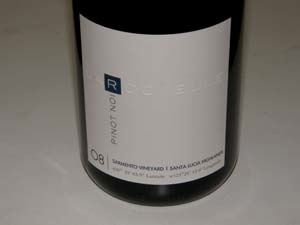 2008 La Rochelle Sarmento Vineyard Santa Lucia Highlands Pinot Noir 15.3% alc., 141 cases, $48. Release spring 2011. · Moderately light reddish-purple color in the glass. The nose is all oak initially, opening with air to reveal very appealing aromas of black cherries and vanilla spice. The wine possesses intense mid palate fruit of the highest pedigree yet is light on its feet (as in iron fist in a velvet glove). Delicious core of black cherry and black raspberry fruit with a touch of cola. A striking wine that is smoothly textured and finishes with an impressive peacock tail of fruit. Higher in alcohol, but not the least bit over ripe or jammy.
Lucienne Vineyards A newer producer of Pinot Noir ( first vintage was 2006) which is a premium winery within the larger Hahn SLH Estates owned by Nicholas Hahn. The winery takes its name from two sources: Nicky Hahn’s middle name Lucien, but in the feminine form to honor the namesake of the mountain range where the vineyards are located. The range was named by the Spanish padres who came to California to build a series of missions in the eighteenth century. Santa Lucia is associated with light; she was known for arriving with a crown of candles to bring light to the darkness during the yuletide and winter solstice. The padres undoubtedly saw the luminescence of the mountain range and called it Santa Lucia. Her crown of candles graces the Lucienne label. The winemaker is Paul Clifton whose recent releases of Lucienne Pinot Noir from the estate Lone Oak Vineyard and Doctor’s Vineyard have been impressive. I did not find this vintage as appealing and perhaps these wines need another 6 to 12 months in bottle. Lucienne wines are available through the Hahn Family Wines website at www.hahnfamilywines.com.
2009 Lucienne Lone Oak Vineyard Santa Lucia Highlands Pinot Noir 14.5% alc., pH 3.70, TA 0.61, 138 cases, $50. Released May 2011. 146 acres planted to clones 777, 115, Pommard, 2A and 667. Aged in 35% new French oak barrels. · Moderate reddish-purple color in the glass. Muted fruit on the nose with prominent smoky oak. Medium weighted array of spicy dark red fruits, with notes of oak-derived vanillin, smoke and tar. No change the following day from a previously opened and re-corked bottle. A bit muddled now. Decent.
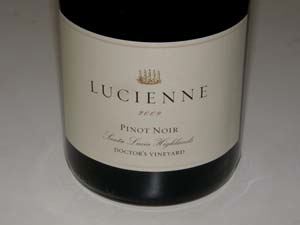 2009 Lucienne Doctor’s Vineyard Santa Lucia Highlands Pinot Noir 14.5% alc., pH 3.58, TA 0.63, 647 cases, $50. Released May 2011.11 different clones of Pinot Noir planted in this vineyard of 243 acres including Calera, 828, 777 and Swan. Aged in 35% new French oak barrels. · Moderate reddish-purple robe. Aromas of ripe raspberries and cherries. Tasty core of cherries, red plums and vanilla. A lighter, elegantly styled wine with a lingering fruit presence on the bright finish. Good (+).
Willowbrook Cellars Winemaker Joe Otos has recently released two JCO Limited single vineyard Pinot Noirs. Willowbrook is a partnership between Otis and retired technology executives John Tracy and Ed Sillari. I have had a number of intriguing Pinot Noirs from Joe who works out of a winery in the Vacu-Dry facility in Sebastopol (Owl Ridge). this past year I reviewed a Sonoma County Pinot Noir bottling that was an amazing value ($24) and won many Gold Medals at prestigious wine competitions. Willowbrook wines are available through the winery’s website store and some fine wine retailers. Visit www.willowbrookcellars.com.
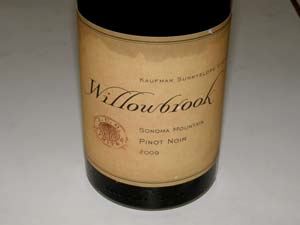 2009 Willowbrook Kaufman Sunnyslope Vineyard Sonoma Mountain Pinot Noir 14.4% alc., 192 cases, $42. Released July 2011. This vineyard is located between the Silver Pines and Van der Kamp vineyards in the western corner of Sonoma Mountain. 7 acres of Dijon clones and clone 23. The site receives 180-degree intense sun and intense winds in the afternoons. · Moderate reddish-purple hue in the glass. Alluring aromas of red cherries and red raspberries with hints of spice, toasted brioche and rose petals. Medium weighted flavors of red cherries and raspberries echo the aromas with supporting oak in the background. Nicely spiced with an appealing savory edge. Well-structured with fine grain tannins suggesting age ability. Very Good.
2009 Willowbrook Chileno Valley Vineyard Marin County Pinot Noir 14.2% alc., 134 cases, $42. Released March 2011. Aged 17 months in French and Polish oak. This vineyard is located in the northernmost part of Marin County, an area known for late, lingering fog and intense, cool winds from Point Reyes. Vineyard management is by Mark Pasternak. · Moderate reddish-purple robe. Aromas of strawberries, dark red raspberries and loamy earth. Smoky, earthy and rustic with flavors of plums, black currents and dark raspberries. The mouth feel is soft and the tannins are powdery. Bright acidity contributes a little sharpness on the finish. Good.
Still More (Mostly) Princely Pinots
 2009 A.P. Vin Turner Vineyard Sta. Rita Hills Pinot Noir 14.6% alc., $39, screw cap. · Moderate reddish-purple color in the glass. Shy but pleasing scent of berry jam becoming very charming with air. Dark, dense and richly fruited with an earthy undertone. Satiny on the palate with well-honed tannins and a fruity, dry finish. This vineyard has become a reliable source of outstanding Sta. Rita Hills Pinot Noir. Very Good.
2009 A.P. Vin Ridgetop Vineyard Sonoma Coast Pinot Noir 14.5% alc., $39, screw cap. · Moderate color intensity. Handsome aromas of fresh berry pie and strawberry shortcake. Quite tasty black cherry and dark raspberry flavors with hints of spice and oak and a finishing note of stem and earth. Silky smooth with supple tannins. When tasted the next day from a previously opened and re-corked bottle, oak-derived coffee flavors were prominent. Good.
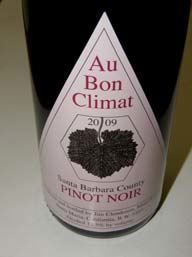 2009 Au Bon Climat Santa Barbara County Pinot Noir 13.5% alc., $19. · Lightly colored in the glass. Very appealing in the glass with bright aromas of strawberries, red cherries, spice and sandalwood. Moderately light in weight with crisp and refreshing flavors of red cherries and a very slight confected tone. Silky with slippery tannins and well-integrated oak notes in the background. A modest but spirited daily drinker that will work beautifully at the dinner table. Very Good.
2009 The Bohan-Dillon Hirsch Vineyards Sonoma Coast Pinot Noir 13.1% alc., $26. · Moderately light reddish-purple color in the glass. Nicely perfumed with aromas of red and black berries, mushrooms and forest floor. Light to medium weight flavors of dark red fruits with a slight stem and herbal note, finishing with a crisp and uplifting riff. Good.
2008 Conspire Russian River Valley Pinot Noir 14.4%, $30. · Moderate reddish-purple robe. Demure aromas of black cherries with heavy oak in the background and a strange “auto garage” scent. Relatively light weighted black cherry core with a burnt flavor and prominent oak. Could be an off bottle. Decent at best.
2008 Verve Sonoma Coast Pinot Noir 14.5% alc., 175 cases, $24. Crane Vineyard. · Moderate color in the glass. Complex aromatic profile offering scents of strawberries, cherries, cola, spice, red plum and a hint of gun powder. Tasty core of cherry cola flavor with a light tarry, toasty, smoky note in the background. Mild dry tannins and a fruity finish. Slight smoke taint but otherwise fine. Good.
Veranda Pinot Noir From ChileChile is well known for its inexpensive red wine imports to the United States included blended reds and singlevarietal wines of Carmenere, Cabernet Sauvignon, Merlot, Syrah, Sauvignon Blanc, Riesling and Chardonnay. About 75% of Chile’s wine production is exported, primarily to the United States and the United Kingdom. Chile is located on the western coast of South America and bordered by the Pacific Ocean to the West and the Andes Mountains to the East. The climate in most of Chile’s winegrowing regions is similar to that of California’s Napa Valley and France’s Bordeaux region. There are a small cadre of Pinot Noir producers located in the Bio Bio, Casablanca, Calchagua, Leyda and San Antonio Valleys focusing on small production, quality-driven Pinot Noir. Chile has followed the historical progression of California in that early plantings of Pinot Noir were in the wrong places such as the Casblanca Valley floor. The vines were over cropped and the wines vinified like Cabernet Sauvignon. Vintners eventually discovered the best cool climate sites and planted the proper clones in regions extremely close to the Pacific Ocean where ripening is challenging, similar to California’s Sonoma Coast.
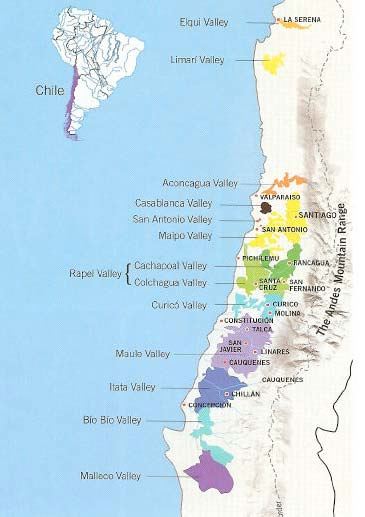 Producers to look for include Casa Marin, Cono Sur, Kingston Family Vineyards, Leyda Vineyards, Matetic Vineyards, Morandé, Piedra Feliz and Valdivieso, Veramonte, and Viña La Misión. A number of these wineries have had consulting winemakers from the United States and France. Veranda Winery is a joint venture between VC Family Estates, owned by the Ibanez family of Chile, and Boisset, a large wine conglomerate in France and California. Veranda makes a range of varietals include Cabernet Sauvignon, Carmenere, Syrah, Sauvignon Blanc, Chardonnay and Pinot Noir. Since the 2007 harvest, Veranda sources its Pinot Noir grapes solely from its estate organic vineyards in the Bio Bio Valley. The winemaker at Veranda is French-Canadian Pascal Marchand who assumed world wide recognition for the wines he crafted at Clos des Epeneux in Pommard, and later at Domaine de la Vougeraie. The wines sampled below were quite good, especially at their price point.
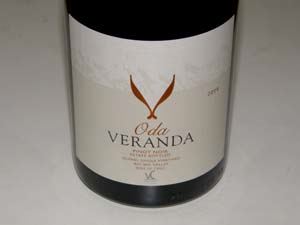 2009 Veranda Negrete Single Vineyard Bio Bio Valley Chile Pinot Noir 14.5% alc., $17. Imported by Saranty Imports, Harrison, NY · A savory aromatic profile featuring scents of black cherries, spice, oak and eucalyptus. Soft and elegant in style with tasty cherry fruit wrapped in muscular tannins. Comes together over time nicely in the glass. Will match up beautifully with a steak. Very Good.
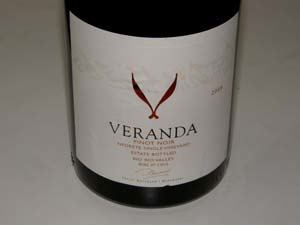 2008 Veranda Oda Quinel Single Vineyard Bio Bio Valley Chile Pinot Noir 14.0% alc., $20. · Moderately dark reddish-purple color in the glass. Vibrant aromas of dark stone fruits with hints of rose petal, raisins, currants and maple syrup. Flavors of modestly rich dark stone fruit are fine but veer toward over ripeness. Firm, vigorous tannins are evident. Good.
Where to Find the Good StuffHere is a frequent scenario. You read about a Pinot Noir in the PinotFile that you must have. You head to the website but the wine is sold out or available to wine club or mailing list members only. You sign up for the mailing list, but in the meantime you just have to have the wine. Here are a list of trustworthy sources of premium Pinot Noir on the internet.
Auction sites
Retailers
Wine search engines
Pinot Briefs
 Family Winemakers of California Tasting 307 wineries will be pouring at this massive tasting on August 21 &22, 2011 at Fort Mason Center in San Francisco. Varietals being poured run the alphabet from Albarino to Zinfandel. A list of participating wineries and the varietal map is at www.familywinemakers.org. Annual production levels of participating wineries begin at 200 cases with prices ranging from $9 to $200 per bottle. The trade will be able to attend both days but the event is open to the public only Sunday, August 21, from 3:00-6:00. Tickets are $65 in advance. New Anderson Valley Census The latest census reveals 2,244 bearing acres as of the 2010 harvest. More than half of the acreage is planted to Pinot Noir (1,453 acres on 76 properties, an increase of 255 acres since 2006), but seventeen different varieties are planted. 45% of the total acreage is Fish-Friendly Farming certified. Planted acreage has increased by 91 acres since the last census in 2006. Read the complete vineyard census, including a breakdown by variety and decade planted, at www.avwines.com. Twenty-four tasting rooms are now open to the public with regular hours or open by appointment in Anderson Valley. Breggo’s second tasting room in the town of Mendocino and Jim Ball Vineyard’s Philo tasting room have closed. Four tasting rooms (Foursight Wines, Londer Vineyards, Philo Ridge Vineyards and Zina Hyde Cunningham) have joined to form Wineries of Downtown Boonville, representing a full day of wine tasting within walking distance of each other. The group calls the walk, “Fratty Pike,” a Boontling term for “Wine Walk.” The group has a Facebook page (www.facebook.com/BoonvilleWineries. Foursight Wines to List Ingredients Foursight Wines will be the first Anderson Valley winery to list ingredients on one of their wine labels, and among the first in the United States to include a statement for vegetarian and vegan wine drinkers. This August, the winery will bottle a 2010 Charles Vineyard Semillon that lists ingredients used (grapes and sulfur dioxide) on the back label, followed by a statement that reads, “This wine is suitable for vegetarians and vegans,” indicating that no animal-derived ingredients were used in the winemaking process. The TTB did not allow Foursight to list “wild ML” on the 2010 Semillon label but the winery plans to pursue this further with the TTB’s Regulations and Ruling Division. For more information about Foursight Wines, visit www.foursightwines.com or view the winery’s blog at www.foursightwines.blogspot.com. Burgundy Food and Wine Eleanor Garvin and Dennis Sherman of Elden Wine will launch Burgundy Country Cooking and Burgundy Wine Weekend Getaways in November, 2011. The pair will offer small group culinary tours and weekend getaways. They have lived in Burgundy for over 25 years and work with small domains “that make Burgundy the way Burgundians like it.” Their cooking classes stem for their knowledge of the local markets, the farmers, the artisans and the winemakers. They also offer a range of intensive tastingbased courses for Burgundy lovers in collaboration with BIVB Ecole des Vines, the Burgundy Wine Institute based in Beaune. Visit www.eldenwine.com or www.burgundyfoodandwine.com. Aubert Wines Has New Winery & New Pinots Mark Aubert and his wife have a new winery facility in Calistoga along the Silverado Trail. The winery is slated to open in January 2011 after a renovation of the previous winery and visitor’s area. In the 2009 vintage, two new single vineyard Pinot Noirs are being released: 2009 Ritchie Vineyard and 2009 UV-SL Vineyard. Aubert planted 4 acres of Pinot Noir at the Ritchie Vineyard on a slope and site that has ideal terroir. At UV-SL, Aubert planted nearly 9 acres at this site located high above the town of Occidental. Both are planted to Aubert’s favorite Pinot Noir clones matched with low vigor rootstocks. Aubert wines are only sold through an allocated mailing list (www.aubertwines.com). Grape to Glass The 16th Annual Grape to Glass Weekend in the Russian River Valley will be held August 19-22, 2011. Two wine seminars and a vineyard tour at three of the Russian River Valley’s premier vineyard properties (Dutton Ranch, Saralee’s Vineyard and Leras Vineyard) will be held. Various wineries and vineyards are offering special deals and events at their tasting rooms throughout the weekend. The highlight of the weekend is the Hog in the Fog Pre-Harvest Party on Saturday, August 20 at Richard’s Grove and Saralee’s Vineyard in Windsor. The ultimate BBQ menu will be created by local chefs and growers with live and silent auctions, a farmer’s market and live music. Many of the top Russian River Valley Pinot Noir producers will be pouring including Arista Winery, Benovia Winery, Dutton-Goldfield Winery, George Wine Company, Inman Family Wines, J Vineyards & Winery, Joseph Swan Vineyards, Martinelli Winery, Mueller Winery, Papapietro Perry Winery, Siduri Wines, Thomas George Estates, T.R. Elliot and Williams Selyem. For information and tickets, visit www.rrvw.org/grape-to-glass-2011/. Drink Wine With Dinner Day On August 15, Julia child’s birthday, the inaugural “Drink Wine With Dinner” Day is proposed nationwide and potentially worldwide by Rosina Wilson who writes the newsletter, WineFoodBUZZ (free subscription) at www.rosinawilson.com. Sonoma Winemaker Second Best on ‘Bachelorette’ Ben Flajnik proposed to bachelorette Ashley Hebert on the television program’s last episode but she spurned his offer, choosing instead the other finalist, J.P. Rosenbaum. Flajnik is the winemaker for Evolve Winery in Sonoma Valley, a partnership with friends Michael Benziger and Danny Fay. Evolve wine (Cabernet Sauvignon, Sauvignon Blanc and Russian River Valley Pinot Noir) has been selling like crazy, even nationally. Visit www.evolvewines.com.
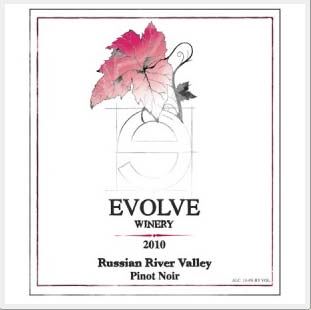 Direct-To-Consumer Market Thrives The pressdemocrat.com reported in July that small and midsize wineries that had strong direct sales programs outperformed the rest of the wine industry in the recent downturn. Daily wine shipments at wineshipping.com, a Sonoma business that assists wineries in filling orders, increased during the recession and continues to increase. 38 states now allow California wineries to ship directly to them. Shipments to states outside California have been increasing and now shipments to California only amount to 32% of direct shipments. The advantage of direct shipment to smaller wineries is obvious: better profit margins and no haggling with a dwindling number of distributors who prefer to distribute more profitable large quantities of wine. The Wine Advocate’s New Voice in California Antonio Galloni is assuming the responsibilities from Robert Parker, Jr., of reviewing California wines. Galloni, who comes from the asset management industry, also reviews wines from Italy and Champagne for the Wine Advocate. Galloni plans to expand coverage to under-reported regions of California such as the Santa Cruz Mountains. The big question is whether his palate will mimic Parker’s and many previously highly reviewed wineries are a little anxious over this change.
 Wine Scoring Backlash Scorevolution is a new movement created to bring people together who disdain the scoring of wine. Interested participants can visit and sign the online petition at www.scorevolution.com, agreeing that scores should not be used to buy or sell wine. The stated goal of the new movement is to encourage people to find wines based on writings and word of mouth. The power of scores is said to limit the discovery of numerous grower wines, encourage formula wines, and even influence the creation of brand icons and inflated price scenarios. Notable signers of the Scorevolution manifesto are Kermit Lynch of Kermit Lynch Wine Merchant, Randall Grahm of Bonny Doon Vineyard, Rajat Parr of Michael Mina Restaurants, Jonathan Nossiter, author of Liquid Memory and director of Mondevino, and Cameron Winery of Oregon. The movement is not against wine critics and wish to encourage people to read about wine and ask sommeliers and those behind counters for guidance. “What we are asking is that people go deeper than a score.” Christophe Hedges of Hedges Family Estate says, “Wine can’t be zipped up into a number any more than a painting by Cezanne can. Wine is about romance and individuality.” Multiple Terroirs of Russian River Valley Delineated Steve Heimoff wrote an excellent article titled, “Russian River Pinot Noir The Triumph of Terroir,” published recently in the Wine Enthusiast (September 2011). Many wine consumers think of the Russian River Valley as a homogenous region with wines from different areas of the valley having uniformity. Heimoff correctly points out that the valley is so vast (126,000 acres) and diverse that the wines from different areas (terroirs) exhibit subtle differences. He says, “For PInotphiles with discerning palates, knowing these differences can help them zero in one the wines that are most likely to offer deep enjoyment.” Most winemakers divide the Russian River Valley into the following sub areas: Middle Reach, Santa Rosa Plain Laguna Ridges and Green Valley and these are well known areas with names in common usage. Additional areas include Western River Road, South of Highway 12 and East of Highway 101. Heimoff points out that these represent seven distinct terroirs. The more southerly and westerly the vineyard is, the cooler it will be. An excellent map showing these seven terroirs is included in the article. ¡Salud! Sip on August 13 The Oregon Pinot Noir Auction launches its 20th Anniversary with ¡Salud! Sip, a day for collectors of ¡Salud! Cuvées to open their bottles and share their tasting experiences with the online social community. Top restaurants in Portland and the Willamette Valley are waving their corkage fees for patrons sharing their ¡Salud! Cuvée wines on Sip day. ¡Salud! supporters are encouraged to enjoy these unique bottlings at home or at partnering restaurants and share their tasting notes and photos through online social networks Facebook (www:facebook.com/saludauction) and Twitter (@saludauction.com). The 20th Anniversary ¡Salud! Pinot Noir Auction will be held November 11 and 12, 2011. Tickets are $395 which include the Big Board Auction at Domaine Drouhin Oregon and Saturday Dinner and Auction Gala at the Governor Hotel in Porland. Tickets are available through www.saludauction.org. Sonoma’s Landmark Vineyards Sold Fiji Water and parent company Roli Global are buying Sonoma’s Landmark Vineyards, a top producer of Chardonnay, Pinot Noir and Syrah. The sale includes the winery, inventory and an 11-acre vineyard. Landmark buys most of its grapes from well-known Pinot Noir vineyards such as Kanzler, Sangiacomo and Bien Nacido. Production is about 20,000 cases annually. Wine Now Preferred Equally To Beer for U.S. Drinkers The latest Gallup poll finds that there are now about the same number of U.S. wine drinkers (35%) as beer drinkers (36%) with liquor registering third at 23%. Younger adults show a declining preference for beer and a slight increase in preference for liquor and wine. Nearly 50% of male drinkers most often drink beer, while 51% of female drinkers choose wine. Older adults tend to prefer wine. Wine is most popular in the East, while beer is preferred in the Midwest, and liquor is most popular in the South and West. In 2005, wine popularity surged to 39%, but beer regained the top spot until this year. Wine Enthusiast (May 2011) published U.S. bureau of Labor statistics for 2009 revealed in 2010. 37% of Millennials drank wine at least every week in 2005, 57% in 2010. 41% of Gen X drank wine at least every week in 2005, 62% in 2010. 41% of Baby Boomers drank wine at least every week in 2005, 57% in 2010. Among those 65 and over, 48% drank wine at least once a week in 2005, 58% in 2010. Wine License Plates for Oregon SB442 passed both Houses allowing Oregon drivers to display a license plate showing an Oregon vineyard and the words “Wine Country.” The license plate will cost $30 above normal car registration fees. The DMV has yet to approve the design. The money collected from sales of the license plate will be used by Travel Oregon to promote Oregon culinary and wine travel. California, are you awake?
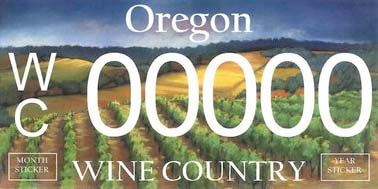 Peter Michael Releases First Estate Pinot Noir More than a decade in the making, Peter Michael has announced the first release of Estate Pinot Noirs from the Seaview Vineyard located on the rugged ridges of the true Sonoma Coast. Three wines will be offered from different parts of the vineyard: Ma Danseuse, Le Caprice, and Clos due Ciel. In 1998, the winery purchased a 400-acre parcel on the first ridge inland from the coast above the South Fork of the Gualala River. 30 acres have been developed as vineyards, with the remainder reserved as a wildlife corridor. 25 acres were planted in 2006 and an additional 5 acres were planted in 2007. The vines are located on moderate to very steep slopes at 1,000 to 1,500 feet above sea level. Soils are a patchwork of rocky alluvial sediments, decomposing volcanic material, and clay. All blocks have been planted to carefully selected Burgundian field selections on a mix of rootstocks. Peter Michael Winery made its first Pinot Noir, Le Moulin Rouge, 13 vintages ago with fruit sourced from the Pisoni Vineyard, and will continue to produce this wine. Peter Michael wines are sold through an allocated mailing list at www.petermichaelwinery.com. A classy newsletter is published twice yearly. Oregon Wine Country Half Marathon The 2011 Oregon Wine Country Half Marathon features a scenic course through the heart of the Willamette Valley in Yamhill County, beginning at Stoller Winery and finishing in the town of Carlton for a post-race Wine & Music Festival. A Race Dinner will be held the night before at Evergreen Aviation & Space Museum and a Wrap Party will be held Sunday afternoon after the race at Stoller Vineyards. See the official 2010 race video here: www.run4oregonwine.com/photos-videos.aspx. Register at www.run4oregonwine.com.
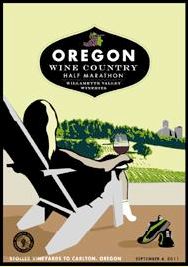 Ceja Vineyards Plans New Winery Napa’s Ceja Vineyards celebrated its 10th anniversary July 16 with a fiesta and unveiled plans for a new mission-style winery which will include a modern production facility, hospitality center, kitchen and landscaped grounds. Construction will begin later this summer. Amelia Ceja, owner and principal of Ceja Vineyards, located in Carneros, said, “The opening of our new winery has been a labor of love and hard work, and is a dream come true for our family.” Five Ways To Open Wine Without A Corkscrew This is a great article published at TheDailyMeal.com (July 20, 2011: www.thedailymeal.com/5-creative-ways-open-wine-without-corkscrew). Options include “With a coat hanger,” “With a syringe,” “With a phone book,” “With an Ah-So tool,” and “With a serrated knife.” Wineries Often Fall Short In Marketing I receive a fair amount of wine regularly and I am always amazed at how often wineries ignore this opportunity to market their wine and capture the interested consumer. Here are a few suggested enclosures that I have found in wine shipments that really increased my admiration for and interest in the winery: (1) A personal thank you note either hand written or printed and personally signed (2) Information on each wine, honest details about the winery and the winemaker including photos of the owner and or winemaker with bios. (3) Suggested drinking range from vintage. (4) Phone number or e-mail of winemaker or owner so they can be contacted if questions arise. (5) Forms for ordering more wine and perhaps a discount for a re-order. (6) A welcome note to see the winery with instructions on how to visit the winery for a tasting and tour. (7) Recipes with suggestions on what to eat with each wine and proper serving temperatures. (8) Copies of the labels so the consumer can remember the wines they liked. (9) Consider giving your best customers a free bottle of wine; you will be amazed at how much good will this accomplishes.
Breast Cancer, Alcohol & Genetics: Latest Information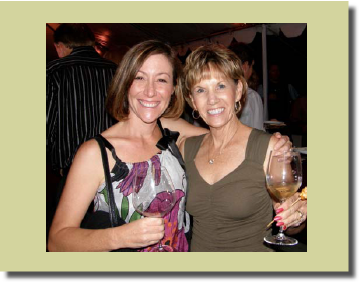 Alcohol consumption increases slightly the risk of breast cancer among women in the general population, but its effect on women who carry a BRCA gene mutation is unclear. BRCA genes function as tumor suppressors but mutations of these genes, which are hereditary, may be harmful. The mutations can be detected with genetic screening. A study published in December 2010 in the medical journal Breast reported a case-control study of 1925 matched pairs of predominantly pre-menopausal women who carry a BRCA1 or BRCA2 mutation. The authors of the study concluded that alcohol consumption did not appear to increase breast cancer risk in women carrying a BRCA gene mutation, and, compared to non drinkers, exclusive consumption of wine was associated with a significant reduction in the risk of cancer among BRCA1 carriers. The same researchers from the Universities of Montreal, Ottawa and Toronto, Canada, plan to publish another study in an upcoming issue of the The Breast Journal. This study was recently summarized by Jacob Gaffney on winespectator.com. The study found that women with the BRCA1 mutation showed a 62% lower risk of breast cancer than the general population if they drank wine, while women with the BRCA2 mutation showed a 58% greater risk. The researchers attribute the difference to the polyphenol resveratrol found in wine. Resveratrol can bind to estrogen receptors and assist in the regulation of activity of BRCA1 mutated genes, but BRCA2 mutated genes appear to be unreceptive to resveratrol. This theory is still speculative and there may be other substances in wine that are decreasing the risk in women with the BRCA1 mutation. The results may also be explained by confounding. Considerable research still must be done to clarify the risks of alcohol and breast cancer in women as the studies are conflicting and inconsistent. It is generally agreed that there is a 6%-10% increase in risk for each drink per day a woman consumes. 12.7% of women will be diagnosed with breast cancer some time in their life. Assuming a 6% increased risk in light drinkers, the risk rises only slightly to 13.5%. The very small risk in women seems trivial when one considers that heart disease causes ten times as many deaths as breast cancer in women and heart disease deaths exceed breast cancer deaths in every decade of a woman’s life. Also, a diagnosis of breast cancer carries more than a 90% cure rate. It is well established that small amounts of alcohol and wine lower the risk of the more common causes of death among women such as heart disease, stroke, hip fracture and dementia. Curtis Ellison, M.D., a well known public health professor, has stated that for women who do not binge drink, have adequate intake of folate, and are not on hormone-replacement therapy, the risk of breast cancer appears to increase only for consumers of more than one and a half drinks per day. Perhaps the greatest health benefit of wine is the gustatory pleasure and its powerful psychological influence. As Julia Child noted, “The fact that people drink wine to relax and enjoy life is, in itself, enough a health benefit for everyone.” |